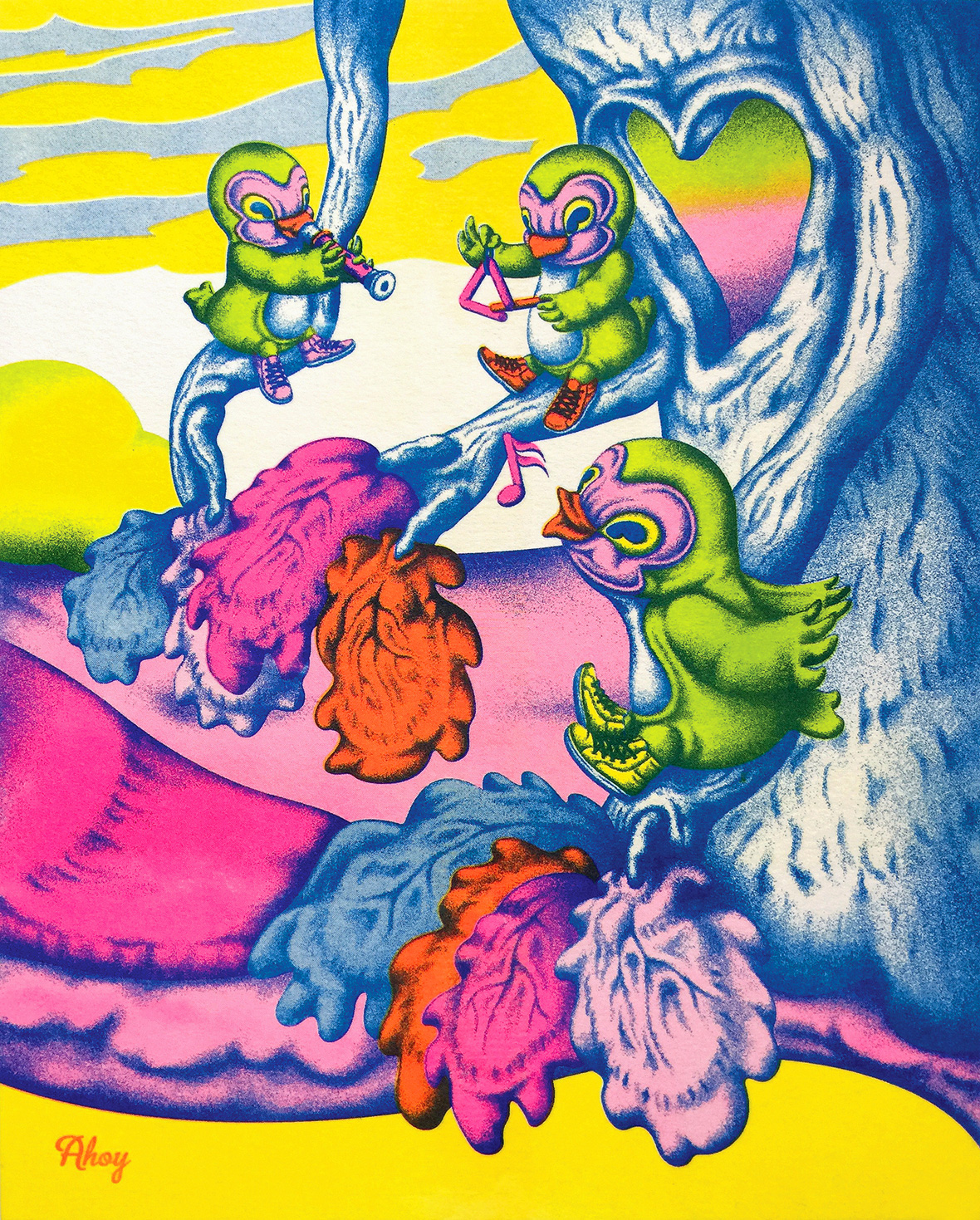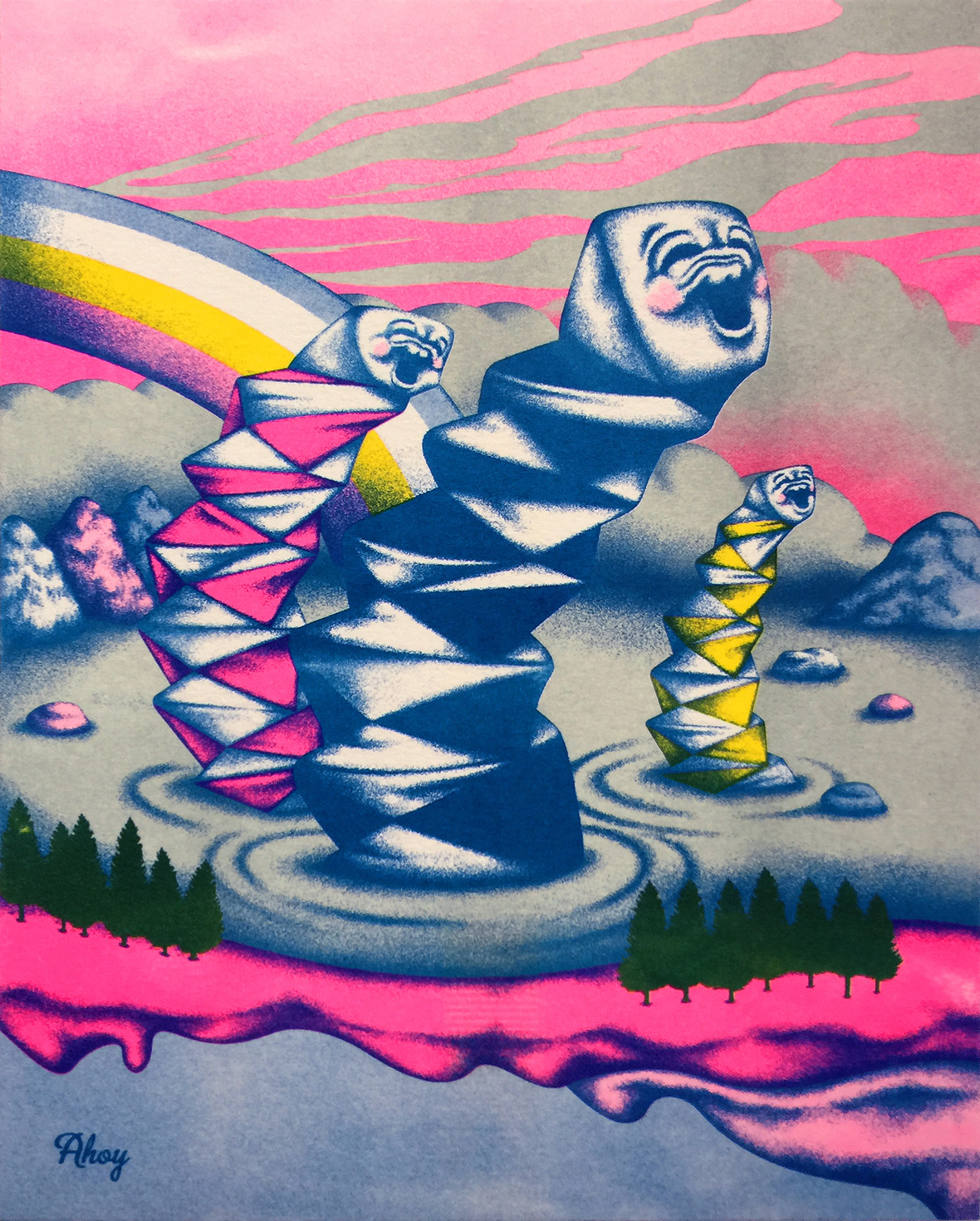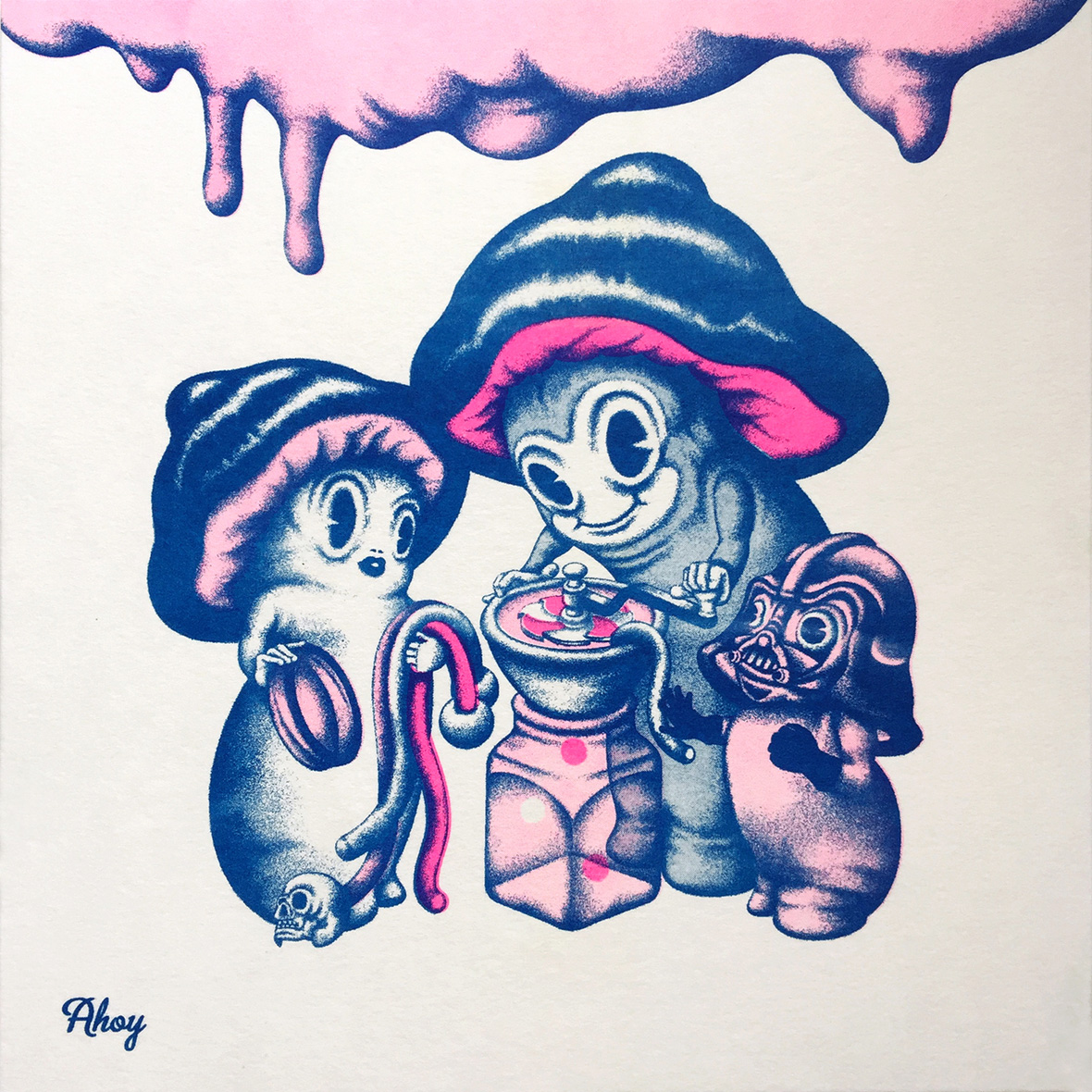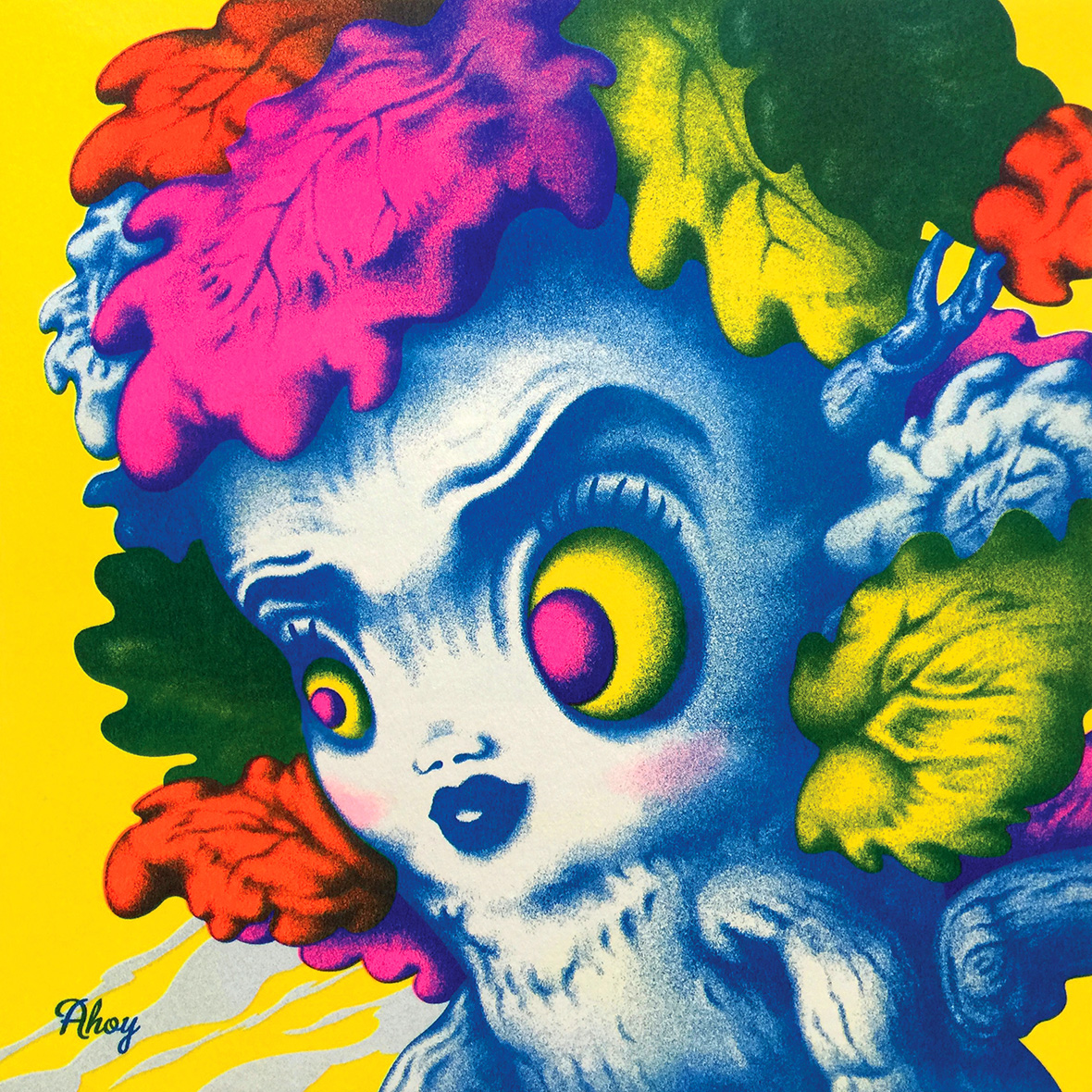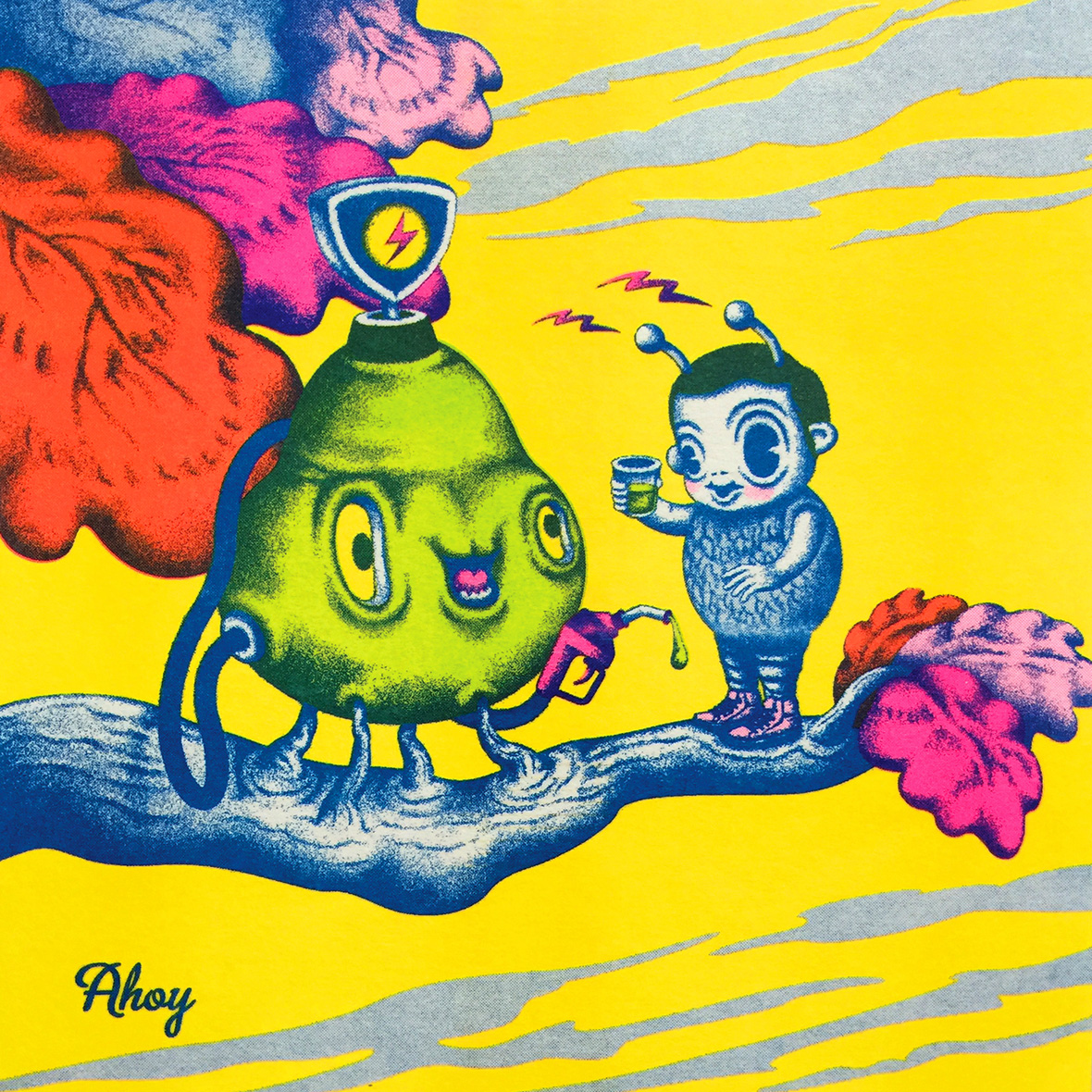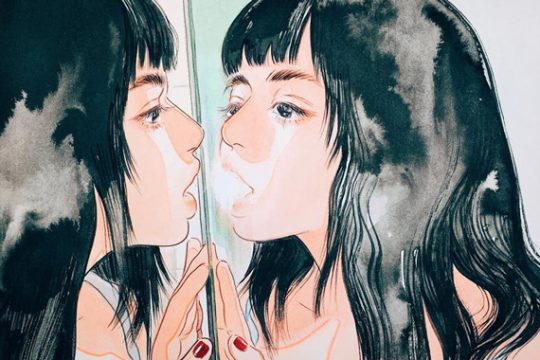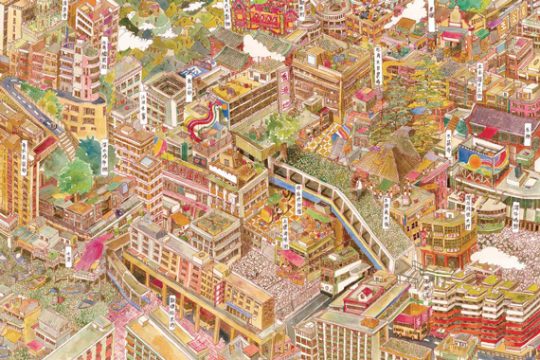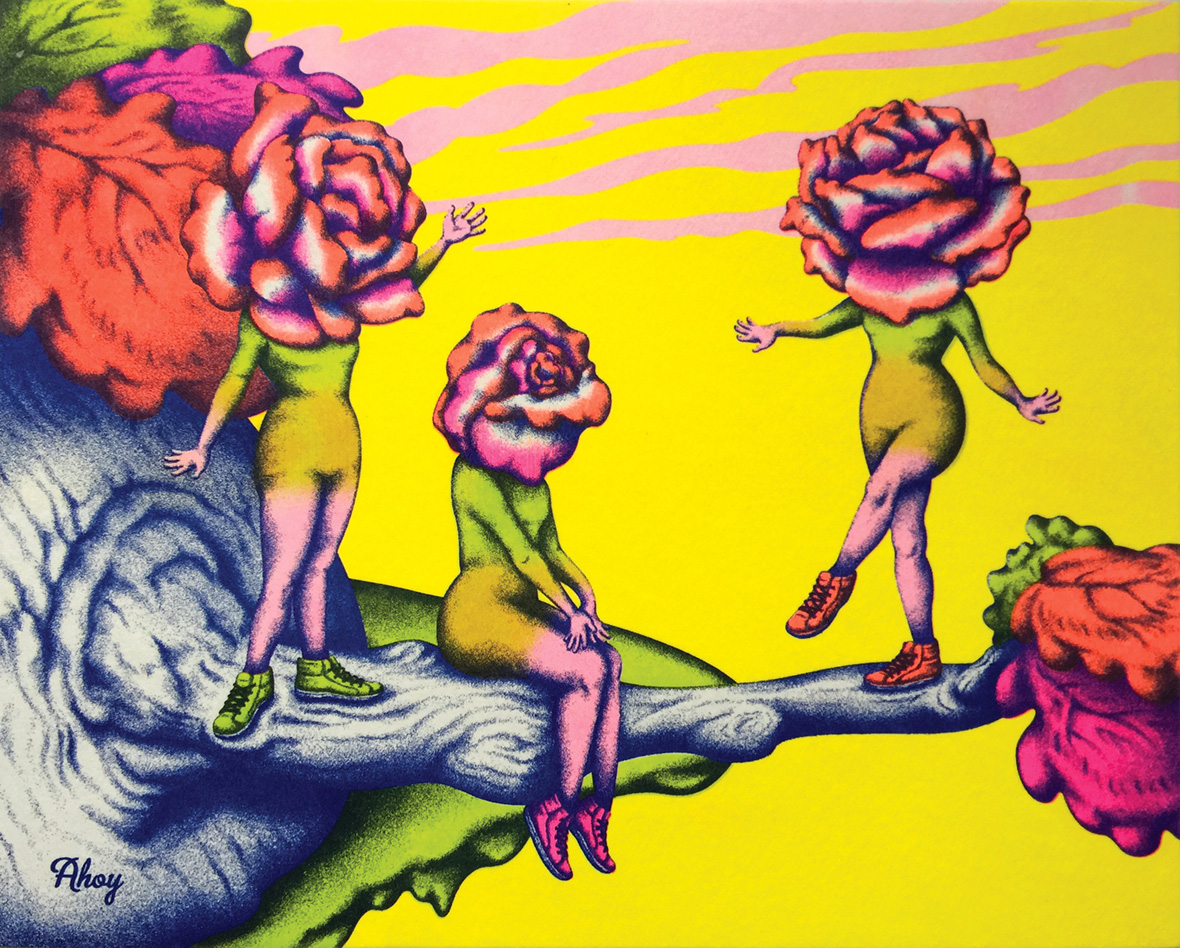
Beneath a fluorescent-colored sky, leviathans with bodies resembling Chinese finger traps tower over lakes, lime-green parakeets rock out on treetops, and rose-headed nymphs frolic from branch to branch—don’t worry, this isn’t an acid flashback. It’s the work of Angela Ho. The Hong Kong artist creates illustrations characterized by vibrant tones, noisy gradients, and dappled lines that work together to produce a retro charm. It’s an aesthetic that may seem at odds with her digital-heavy workflow.
Like Ho, many contemporary artists have furthered their creative potential through technology. Specialized software, pressure-sensitive styluses, and color-calibrated monitors allow creators to realize their artistic vision with clinical precision. Yet often, purely digital pieces end up missing a certain je ne sais quoi. This is something that Ho is increasingly wary of. Despite her reliance on digital tools, she’s looking to traditional techniques and mediums for inspiration.
在荧光色的天空下,有着类似中国棋盘手环样子的巨兽在湖面上飞舞着,青绿色的长尾小鹦鹉在树梢摇摆,玫瑰色的小鹦鹉在树枝间嬉戏——别担心,这不是幻觉闪现。这是 Angela Ho 的作品。这位香港艺术家创作了以充满活力的音调、嘈杂的渐变和斑驳的线条为特色的插图,这些线条共同创造了复古的魅力。这种审美观似乎与她的数字工作流程格格不入。
许多和 Angela Ho 一样的当代艺术家,利用科技发展他们的创作潜能。专业的软件、压敏笔和彩色校准显示器使创作者能够以精确的方式实现自己的艺术视觉。然而,纯粹的数字作品最终往往会漏掉某些东西。这正是 Angela 担心的问题。尽管她依赖数码工具,但她仍在寻求传统技术及媒介带来的灵感。
“I love woodcut printing from the 1950s, ’60s, and’70s with strong simple shapes and lots of texture from the wood,” Ho says. “This printing process gives depth to otherwise flat shapes. Texture in drawings makes them more tactile, like you can see the hand of the artist.”
Ho’s fascination with texture led her to experiment with risography, a printing method from the 1980s that’s found renewed interest in recent years. Risographs are known for producing unpredictable and inconsistent prints, and for many artists like Ho, its fallibility is exactly the appeal, as it makes the art feel more human. “I love the serendipitous nature of risographs,” she says. “I can give up some control over my work.”
“我喜欢上世纪 50 到 70 年代的木刻版画,它们的形状简单,还有很多木头纹理。”Angela 说。“这种印刷过程使平面形状的深度得以加深。在图纸纹理使他们更有触觉,就像你可以看到的艺术家的手。”
Angela Ho 对质地的迷恋,促使她开始尝试将 “risography”(意为“数字复印”)这 80 年代的印刷方法重新引起人们的兴趣。以创作不可预测和前后不一致的版画而著称,对和 Angela Ho 一样的许多艺术家来说,它的不完美正是吸引人的地方,因为它赋予了艺术更多人情味。“我喜欢数字复印的偶然性,可以让我放任一些对作品的控制。”
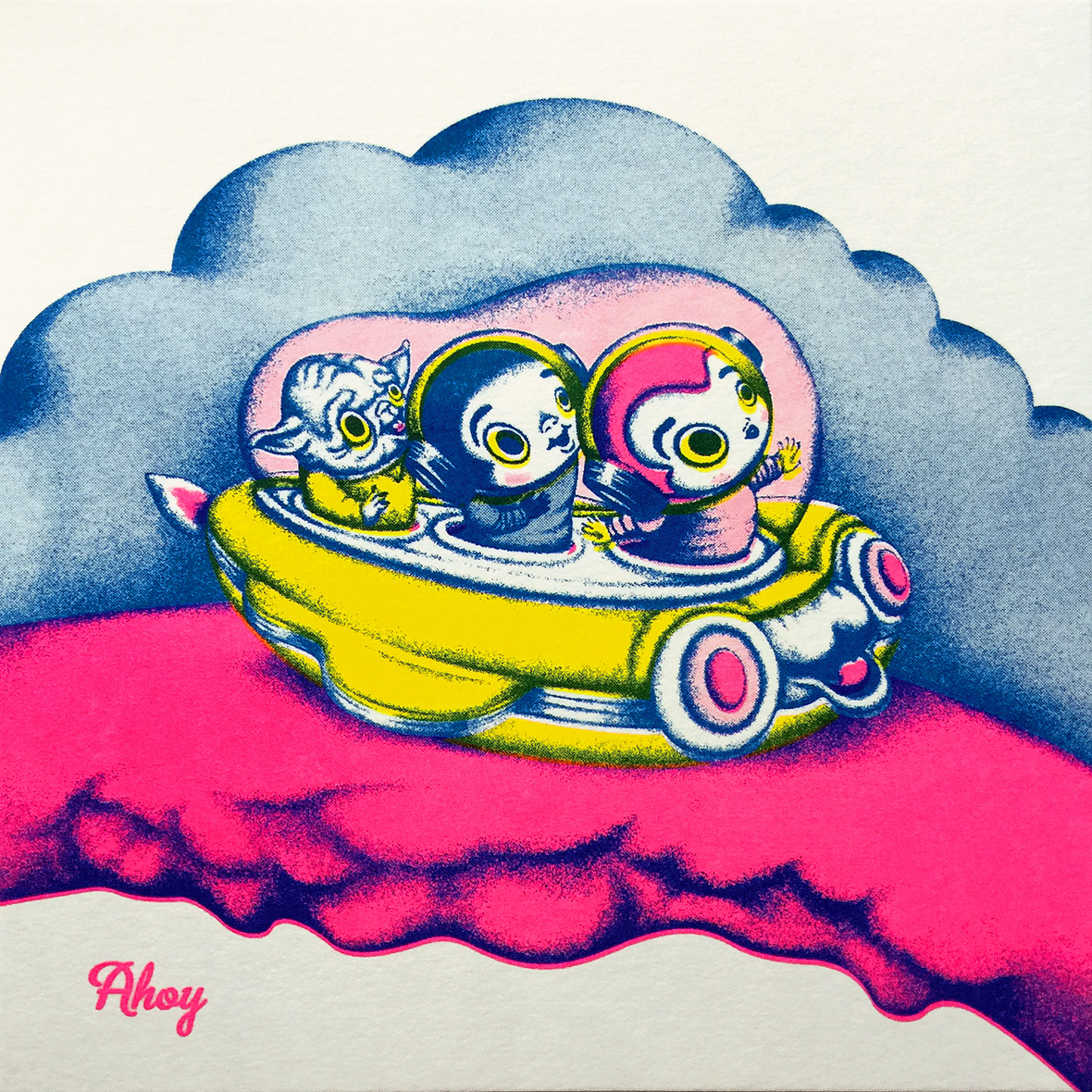
Ho’s appreciation for risograph printing doesn’t mean she’s shying away from new technology though. Her recent exhibition, Interspecies Utopia, held at Outré Gallery in Melbourne, Australia, incorporates augmented reality. Using the Artivive app, viewers can look through their phones to see her static prints come to life. “The AR in my show emphasized the idea of a working society, how each individual is important to it,” she recalls of the original idea. “It was meant to only function when all the characters were put together, when all the artworks were hung together in a specific formation. However, I decided with Outré to separate the animations in the overall AR experience, so that people who bought individual prints could also view the AR specific to their print.”
不过,Angela 对印字法的欣赏并不意味着她对新技术不感兴趣。她最近在澳大利亚墨尔本 Outré 画廊举办的《Interspecies Utopia》(意为“物种间乌托邦”)展览融合了现实。通过 Artivive 应用程序,观众可以通过手机看到她的静态照片栩栩如生。“在我展览中的 AR 技术增强了‘工作社会’的理念,以及每个人在其中的扮演角色重要性。”她回忆起最初的想法,“当所有的角色被放在一起,当所有的艺术作品以特定的形式挂在一起时,它就起作用了。然而,我和 Outré 画廊那边商量决定分开动画和整体 AR 增强现实的体验,使购买个人打印的观众也可以查看 AR 的具体展现。”
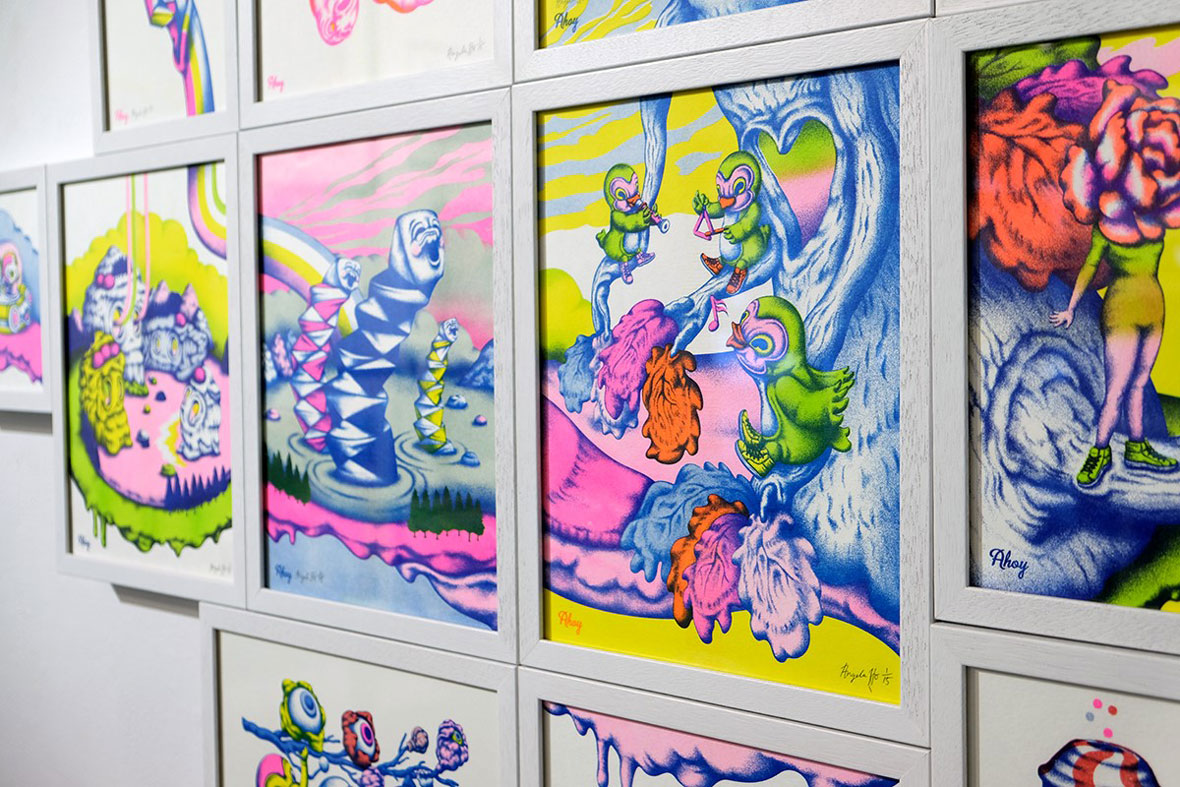
The illustrations in Interspecies Utopia feature the same retro aesthetic that Ho has always been known for, but the series is a marked departure from her earlier works. Rather than making standalone pieces, for this exhibition, she crafted a series with an interconnected narrative. “When my submission was accepted by Outré, I saw it as a chance to make my work evolve,” she recalls. “I’d been drawing lots of characters, often just floating in white space or on flat colors. I was beginning to work with environments and landscapes and wanted to put a range of characters together.”
《Interspecies Utopia》中的插图具有和 Angela 一惯的复古美学特征,但这一系列作品与她早期的作品有明显的不同。这次展览并不是每一幅画都是独立的作品,而是她第一次用相互关联的叙述来创作一个系列。“我的作品被 Outré 画廊选中时,我把它看作是让艺术领域向外拓展的机会。”她回忆道,“我画了很多不同角色,通常只是在空白处或平面上漂浮。我开始研究环境和风景,想把一系列的人物放在一起。”
At first glance, Interspecies Utopia seems to depict a forest sanctuary where all the animals live joyous harmony. But closer scrutiny reveals an underlying tension—it’s almost as if the place is too good to be true.
These feelings of suspicion aren’t unfounded, as the series’ core themes are partly based on racism and discrimination that the artist has faced or observed.”World events, xenophobia, and my own experiences and feelings growing up in Australia and being of Chinese and Hong Kong heritage were all influences,” Ho explains.
Ultimately, Interspecies Utopia is Ho’s way of presenting a simple but powerful message, one that she feels is especially important today: we may all be different, but a little empathy goes a long way in making the world a happier place.
乍一看,《Interspecies Utopia》似乎是在描绘一个和谐的森林,在这里所有动物在一起其乐融融地生活,但仔细观察后,它却揭示了一种潜在的张力——因为它几乎就像是一个美好得不真实的地方。
这些怀疑并非没有根据,因为作品的核心主题都是基于艺术家所面临或观察到的负面经历,尤其是歧视和种族主义。Angela 解释道:“世界上的种种事件、人们的仇外心理,以及我在澳大利亚长大时作为华人和香港移民的身份,对我都是有影响的。”
归根到底,《Interspecies Utopia》是 Angela 一个简单却很有力量的表达方式,她觉得在现代社会中特别重要:我们可能都是不同的,但是人与人之间的共情会让这个世界变得更美好。
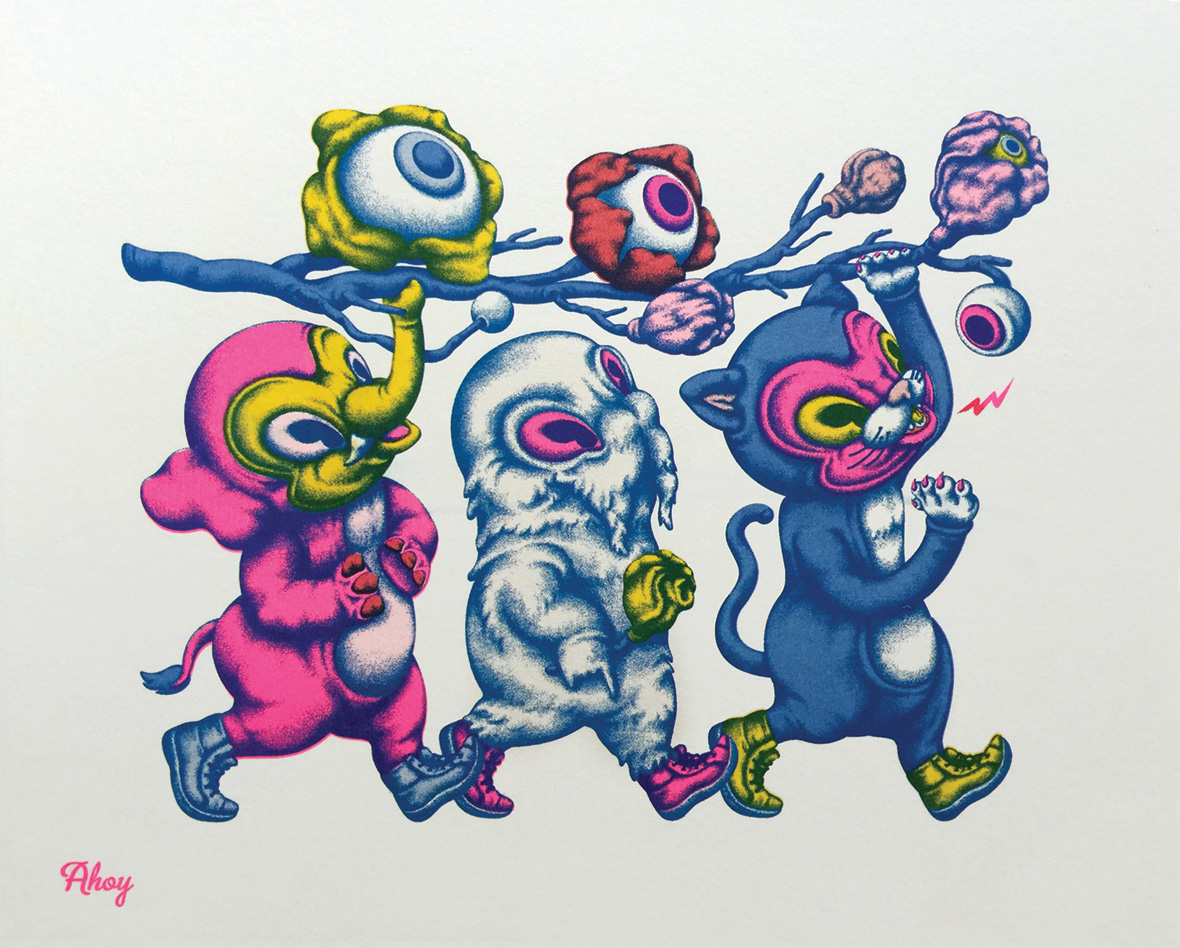
Like our stories? Follow us on Facebook and Instagram.
Website: ahoyillustration.com
Instagram: @ahoyillustration
Behance: ~/ahoyillustration
Contributor: David Yen
Chinese Translation: Chen Yuan
网站: ahoyillustration.com
Instagram: @ahoyillustration
Behance: ~/ahoyillustration
供稿人: David Yen
英译中: Chen Yuan

